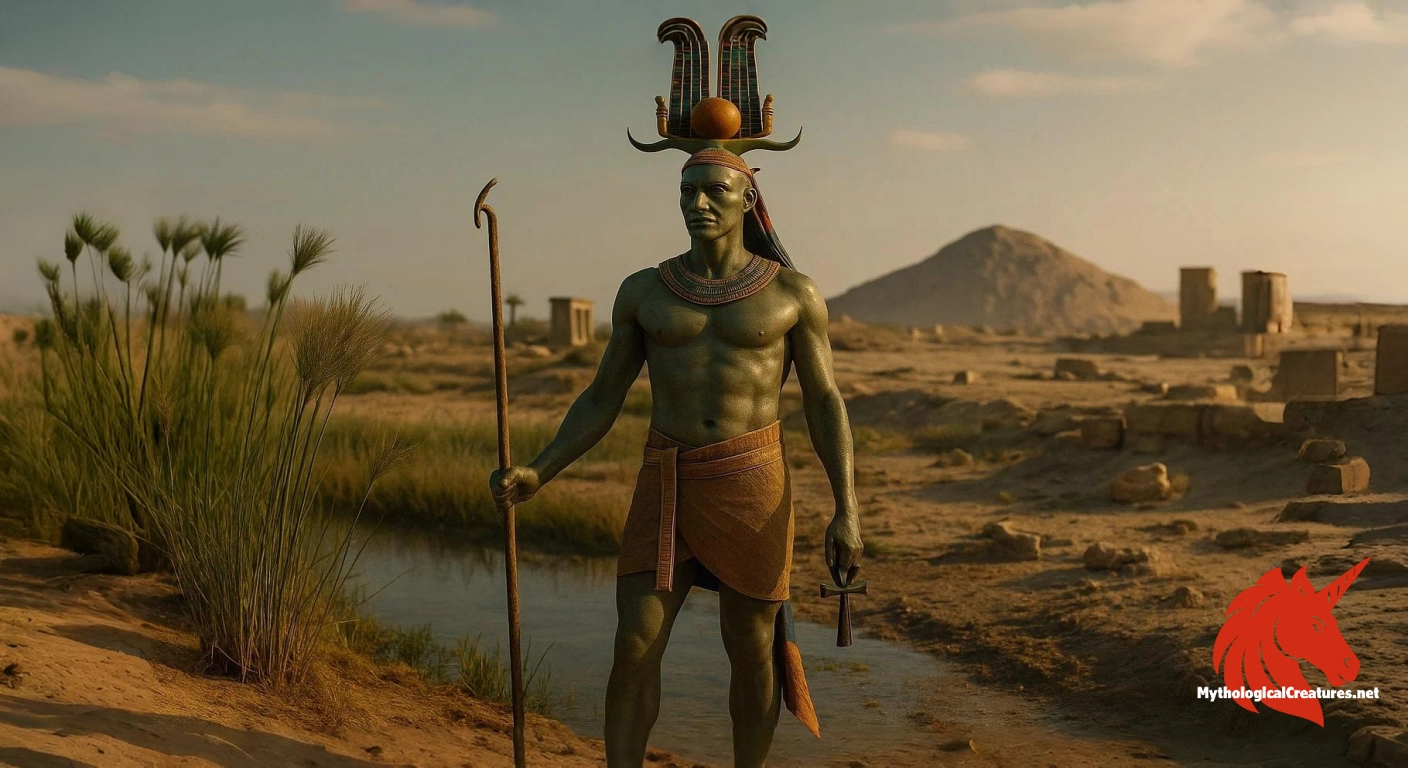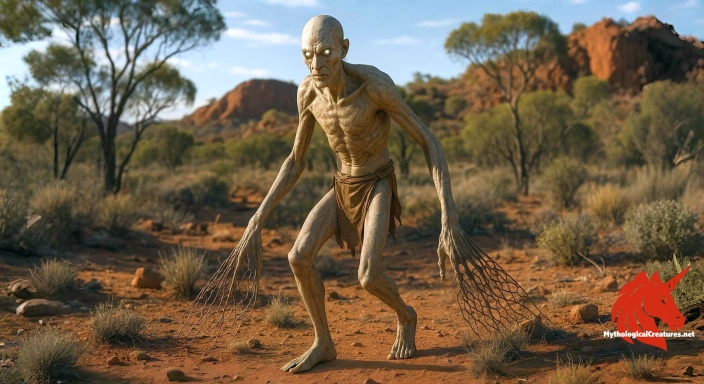Tatenen: Tatenen is an androgynous primordial Egyptian deity symbolizing the risen earth and the creative force behind nature.

Tatenen
Tatenen - Represents the rising earth from chaos, providing sustenance, stability, and guidance for the dead
Origins & First Encounters
Tatenen emerges from the ancient Egyptian pantheon as a deity of the primordial mound and the very embodiment of the earth's creative force. His dual nature, both masculine and feminine, symbolises the balanced and fertile energy that brought the land into existence. The name Tatenen, meaning 'risen land' or 'exalted earth', reverberates with the imagery of the silt-laden banks of the Nile and the fertile soils that sustained life. His origins are deeply intertwined with the moment the earth emerged from the primordial watery chaos, a concept that mirrors the creation of the benben and later monumental structures such as mastabas and pyramids. Historical attestations of Tatenen first appear on funerary inscriptions during the First Intermediate Period and Middle Kingdom, revealing his significance in the spiritual and ritual life of ancient Egypt. As a custodian of nature and rebirth, he played a pivotal role in both agricultural cycles and the afterlife, embodying the continuous renewal of existence. With his association with Memphis, then known as Men-nefer, Tatenen was not only a regional guardian but also an integral component of the broader Egyptian cosmogony. His mythic resonance as both a nurturer and protector underscores his enduring importance in the cultural and religious landscape of ancient Egypt.
Source Texts & Tale Variants
The mythos surrounding Tatenen is woven through several ancient inscriptions and hymns, with his early appearance on coffin texts during the First Intermediate Period providing one of the earliest records of his worship. In Middle Kingdom writings, his name transitions into the form Tatenen, reflecting evolving linguistic and religious practices. A notable source is the Third Intermediate Period hymn known as The Great Hymn of Khnum, where Tatenen is associated with the creator god who moulded all existence on his potter’s wheel. Variants of his name, including Ta-tenen, Tatjenen, and Tanenu, illustrate the fluidity of his character across different periods and textual traditions, each variant offering a slightly different perspective on his role as the deity of the primeval earth. Some texts describe him not only as the progenitor of all gods but also as the embodiment of both creative birth and maternal nourishment. Other narrative strands depict his power in repelling chaos, most notably his triumph over the serpent Apep with the aid of his staff. These primary sources, though fragmentary, reveal a multi-dimensional character whose stories were adapted to various ritual and cultic needs. The diversity of accounts confers a rich tapestry of interpretations, allowing Tatenen to remain a complex figure in Egyptian religious thought.
Form & Powers
While direct physical depictions of Tatenen are relatively rare, his iconography is rich with symbolic elements that evoke the primordial essence of the earth. Artistic representations tended to emphasise his androgynous nature, often combining features traditionally associated with both genders to symbolise the unity of creative forces. He is sometimes envisaged as emerging directly from the primeval mound, embodying the dynamic interplay between chaos and order. In some artistic traditions, he is depicted wielding a staff, an emblem of authority used to repel the forces of evil, most notably the serpent Apep. His magical mace, occasionally dedicated to the falcon, further suggests a link with the celestial and terrestrial realms, reinforcing his role as a protector and progenitor. The textures and motifs associated with Tatenen frequently draw on imagery of silt, soil, and the rugged elements of the earth, symbolising both fertility and stability. Variations in his depicted size and form can be discerned through regional artefacts, with some portrayals emphasising a more expansive, almost cosmic presence while others lean towards a more human scale. Though subtly rendered compared to other deities, Tatenen’s visual attributes consistently invoke the enduring, life-giving power of the natural world.
Regional Faces
Tatenen’s worship was particularly prominent in the Memphis region, where he was revered as a local manifestation of the primeval force that underpinned Lower Egypt’s identity. In this locale, his connection to the land and creation was accentuated by the agricultural traditions and the central importance of the Nile’s silt. Over time, interpretations of his character adapted to regional beliefs and ritual practices, resulting in variations where his functions sometimes merged with those of other earth deities such as Geb or Khnum. In some local traditions, Tatenen came to represent not only the physical landscape but also the spiritual vitality of the region, often being invoked in rituals related to rebirth and resurrection. Regional cults balanced his role as both a cosmic creator and a nurturing patron of the land, reinforcing the link between divine intervention and the prosperity of the community. Local variations also permitted the integration of Tatenen into the broader cosmological framework, where he was seen as a stabilising force during times of social or political upheaval. These local adaptations contributed to a multiplicity of narratives that allowed his myth to resonate with diverse audiences. The regional flavour of his worship highlights the fluidity of myth and religious practice in ancient Egypt, where divine characteristics were continually reinterpreted to meet local needs.
Cultural Parallels
The dualistic and generative nature of Tatenen invites comparison with other deities who embody the fertile creative forces of the earth. Much like the Greek Gaia or the Mesopotamian Ki, Tatenen stands as a personification of the land and a symbol of the primal forces that underpin life itself. His unique amalgamation of masculine and feminine aspects parallels similar themes found in various mythologies, where balanced duality is essential for the creation and sustenance of life. In ancient Egypt, his roles and attributes also share common ground with those of Ptah and Geb, though Tatenen is distinct in his exclusive association with the primeval mound. This comparative framework underscores not only the universality of earth worship but also the particular cultural nuances that defined Egyptian conceptions of cosmic order. While other cultures have celebrated the earth as a source of sustenance and continuity, Tatenen’s narrative is uniquely interwoven with the Nile’s silt and the transformative rituals of rebirth. His depiction as both progenitor and protector creates a bridge between the tangible attributes of nature and the abstract notions of creation and stability. Such cultural parallels reveal a shared human fascination with the origins of life, each tradition colouring this mystery with its own symbols and rites.
Legacy & Modern Evolution
The evolution of Tatenen's myth reflects the dynamic nature of ancient religious thought and its ability to adapt to shifting cultural landscapes. Over the centuries, his depiction transitioned from a fiercely local earth deity to a symbol of universal creative power, blending seamlessly into the broader tapestry of Egyptian theology. In later periods, as religious reforms and syncretism took hold, Tatenen’s attributes were sometimes subsumed within more dominant deities, yet his legacy as a creator and sustainer continued to influence ritual and iconography. Modern interpretations have rediscovered his dual nature and his integral connection to natural cycles, inspiring contemporary art and literature that seek to evoke primal creative energies. Scholars and enthusiasts of mythology appreciate Tatenen for his nuanced portrayal of the earth’s generative capabilities, recognising him as a potent emblem of stability amid chaos. His narrative, though deeply embedded in ancient tradition, resonates with modern themes of environmental connectivity and the cyclical nature of life. In academic and creative fields alike, Tatenen’s myth serves as a reminder of the longstanding human desire to understand and harmonise with the natural world. Today, while not actively worshipped, his story continues to captivate and inform discussions about the origins of life and the enduring power of the earth.
Interesting Fact
Tatenen’s dual gender and his embodiment of both the creative and nurturing aspects of the earth highlight the intricate balance of forces in Egyptian cosmology.
Quick Creature Info
Origin:
Features:
Associations:
Our Mythic Legendary Rating:

Also Sometimes Known As:
Habitat:
Supernatural Powers:
Physical Attributes:
Abilities:
Behavior:
Lore:
References
Discover Another Mythical Legend You May Not Have Heard Of?
Uncover the mysteries of ancient folklore and expand your knowledge of legendary beings from cultures around the world.
Dare to Meet the Thinan-malkia....
Mythical Disclaimer: The images and data on this site are derived from various historical and literary sources, but we have found that many myths often have multiple versions and interpretations across references, sometimes contradictory. As a result, these creature depictions are artistic interpretations—imaginative blends of folklore, legend, and a dash of AI guesswork. Because creature descriptions vary widely, our illustrations and accompanying information represent our best effort to honor mythology while bridging creative gaps. Enjoy these interpretations—just remember, we've done our best to respect the stories and validate available data, but in the realm of mythology, details often shift, imagination leads the way, and nothing is ever set in stone!
Curated by the Mythological Creatures Team (rev. May 2025)
